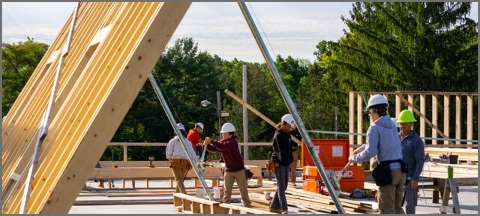DANVERS — Some incoming Essex Tech juniors could have spent their summers on the beach or working odd jobs outside their trades.
Instead, since the end of June, 20 young women and men have been going to school. But instead of going to class, they have been working to renovate eight classrooms.
They are learning how to put a skim coat on walls, hang drywall, install outlets in horsehair plaster and swing a sledgehammer.
They are doing so on the second floor of the school’s iconic Smith Hall administration building along Maple Street, across from the main campus.
And, they are earning $14 an hour working eight hours a day.
For many, this is the first time they have ever been paid to ply their trade and be held accountable for their work, said Essex Tech carpentry instructor Robert Conard, who is helping to oversee the job.
The students, along with their instructors, are fixing up a total of eight classrooms in an under-utilized space formerly occupied by the school’s transportation department.
Superintendent-Director Heidi Riccio said the space was in need of work. Some of the electrical system was made up of the old knob-and-tube wiring.
“So, the goal is, is that once these are all renovated, we can not only use them for the community, but we’ll be able to offer classes here as overflow classes,” Riccio said.
The eight new classrooms will help Essex Tech accommodate adult day learners and a new career and technical education program involving a partnership with Peabody and Salem high schools through the Smith Family Foundation. In the upcoming school year, the plan is to have about 30 juniors, 15 each from Peabody and Salem attend a half day of academics at their schools, and a half day studying construction or advanced manufacturing at Essex Tech. It’s a program the school has piloted with Gloucester.
“Those expansion efforts, the classrooms can be done here,” Riccio said.
The goal is to help the school accommodate more kids. The school’s modern, $133 million campus across the street from Smith Hall, which was also part of the former Essex Agricultural School, opened in 2014 with the merger of the former North Shore Tech, Essex Aggie and Peabody’s high-school vocational programs. The school has about 1,400 students, but it receives more than 1,000 applications for about 350 slots.
Clean energy grant
While the first floor of Smith Hall serves as Essex Tech’s administrative offices, the second floor was underused and in need of updating.
To do something about that, t he school won a $165,000 grant from the Massachusetts Clean Energy Center, a state economic development agency focused on growing t he Bay State’s clean energy sector. It took one year to plan the work, and students also had to apply to the program and take courses to be employable.
“And so it’s a Learn and Earn grant,” Riccio said, “And it is about teaching students renewable energy, sustainability techniques and they are earning money as they do it.”
“By working hand-in-hand with Massachusetts high schools like Essex Tech, we can expose students to valuable experiences in STEM education,” said Craig Gilvarg, a spokesperson for MassCEC. “A highly-skilled workforce is critical to the continued success of the Commonwealth’s vibrant clean energy industry, and the Learn and Earn program will fuel future growth by helping these students develop an important base of knowledge as they explore career opportunities.”
The state money supported the payroll for the students to work this summer. About $35,000 was used for materials, including new LED lighting and split-system air conditioners.
“What they are learning is sustainability techniques, but more importantly is they are also learning how to work together,” Riccio said.
Four different trade occupations at the school are working together: plumbing, electrical, carpentry and HVAC. The students are all incoming juniors, which means they have yet to have a co-op experience where they can gain on-the-job skills.
Riccio said all the students, including the future plumbers, HVAC technicians and electricians, did the demolition work. They also had to hand carry every piece of new drywall up two flights of stairs.
But, they are also getting the experience of working with someone from another trade. It’s and experience that could carry them through tough economic times, Riccio said.




